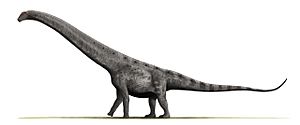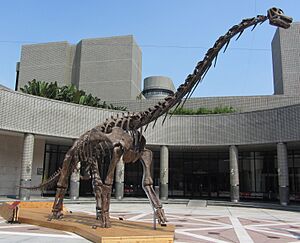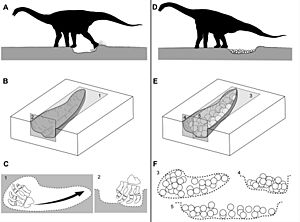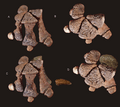Titanosaur facts for kids
Quick facts for kids TitanosaursTemporal range: Upper Jurassic – Upper Cretaceous
|
|
|---|---|
 |
|
| Epachthosaurus skeleton, National Museum, Czech Republic, originally from South America | |
| Scientific classification | |
| Kingdom: | |
| Class: | |
| Superorder: | |
| Order: | |
| Suborder: | |
| Infraorder: | |
| Superfamily: |
†Titanosauroidea
Lydekker, 1895
|
| (unranked): |
†Titanosauria
Bonaparte & Coria, 1993
|

Titanosaurs were a group of huge, long-necked dinosaurs called sauropods. They belonged to a bigger group called Titanosauriformes, which also included brachiosaurs. These dinosaurs were some of the heaviest animals to ever live on Earth.
Some famous titanosaurs include Saltasaurus, Isisaurus, Argentinosaurus, and Paralititan. This group includes the biggest land animals ever known! For example, Patagotitan was about 37 meters (121 feet) long and weighed around 69 tonnes (76 tons). Argentinosaurus and Puertasaurus, found in the same area, were also incredibly huge. They were named after the powerful Titans from ancient Greek myths.
Titanosaurs were the last major group of sauropods before the big extinction event that wiped out the dinosaurs. They were the main plant-eaters of their time. Evidence suggests they replaced other sauropods, like the diplodocids and brachiosaurids, which disappeared between the Upper Jurassic and mid-Cretaceous periods.
Contents
What Made Titanosaurs Unique?
Their skeletons were similar to earlier sauropods, but with some important differences.
Body Shape and Stance
- Their pelvis (hip area) was thinner than some other sauropods.
- However, their pectoral (chest area) was much wider.
- This gave them a unique "wide-gauged" stance. Their front legs were wider apart and usually longer than their back legs. You can see this clearly in the Argentinosaurus.
- Because of this, their fossilized footprints are wider than those of other sauropods.
- Their vertebrae (back bones) were solid, not hollow.
- Their spine was more flexible, meaning they were probably more agile. They might have been better at standing up on their hind legs.
Different Types of Titanosaurs
The titanosaur group had many different kinds of dinosaurs.
- Some smaller types, like Epachthosaurus, did not have longer front limbs.
- One Chinese discovery, Xinghesaurus, had an extremely long neck.
- These differences likely helped them live in different habitats and with different lifestyles. However, scientists are still learning about this, as many of these discoveries are quite new.
Where Did Titanosaurs Live?
Titanosaurs lived all over the world. Their fossils have been found on every continent, even Antarctica. Four well-preserved skeletons of a titanosaur species were found in Italy.
They were especially common in the southern continents, which were once part of the supercontinent called Gondwana. Australia had titanosaurs about 96 million years ago. Fossils of a creature around 25 meters (82 feet) long have been found in Queensland. Remains have also been discovered in New Zealand.
World Record Size
Titanosaurs hold the world record for the size of a land animal. In one place in Argentina, 150 bones from seven titanosaurs were found. The largest bones came from an animal that was about 40 meters (130 feet) long and 20 meters (65 feet) tall. It would have weighed around 77 tonnes (85 tons).
A local farm worker found these remains in the desert near La Flecha, about 250 kilometers (155 miles) west of Trelew, Patagonia.
What Did Titanosaurs Eat?
Titanosaurs were mostly "high browsers". This means they ate leaves and branches from tall trees. This is different from other plant-eaters like Ceratopsia and Ankylosauria, which were "low browsers" and ate shorter plants like shrubs. High browsers can eat lower plants, but low browsers can't reach tall trees.
Like earlier sauropods (such as Diplodocus), titanosaurs had peg-like teeth and no grinding teeth. This means they swallowed gastroliths (stones) to help grind their food. They also had a huge, vat-like stomach where bacteria helped break down their food.
Titanosaur Diet Details
Fossilized dung (poop) from late Cretaceous titanosaurs suggests they ate a wide variety of plants. Besides expected plants like cycads and conifers, they also ate many types of monocotyledons. This included palms and grasses (like ancestors of rice and bamboo). This discovery has led scientists to wonder if plant-eating dinosaurs and grasses grew and changed together over time.
Nesting and Reproduction
A large titanosaur nesting ground was found in Auca Mahuevo, in Patagonia, Argentina. Another nesting area has been reported in Spain.
- Several hundred female saltasaurs dug holes with their back feet.
- They laid clutches of about 25 eggs each.
- They then buried the nests under dirt and plants.
- The small eggs, about 11–12 cm (4–5 inches) across, contained fossilized embryos.
- These embryos even had skin impressions! The impressions showed that titanosaurs were covered in a mosaic armour of small, bead-like scales.
- The huge number of individuals suggests they lived in herds. This herd behavior, along with their armor, might have helped protect them from large predators like Abelisaurus.
Images for kids
-
Manus of Diamantinasaurus, the only titanosaur known to have multiple phalanges
-
Lectotype of Titanosaurus indicus, the name-bearing genus of Titanosauria
-
Holotype skeleton of Opisthocoelicaudia
-
Humerus of Ampelosaurus (left) and Magyarosaurus (right), and femora of (left to right) Magyarosaurus, Lirainosaurus and Ampelosaurus
-
Patagotitan skeleton cast on display at the American Museum of Natural History
See also
 In Spanish: Titanosauria para niños
In Spanish: Titanosauria para niños













